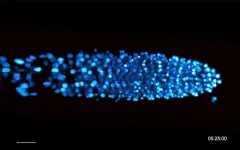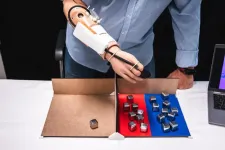(Press-News.org) DURHAM, N.C. -- It might look like a comet or a shooting star, but this time-lapse video is actually a tiny plant root, not much thicker than a human hair, magnified hundreds of times as it grows under the microscope.
Researchers at Duke University have been making such movies by peering at stem cells near the root’s tip and taking snapshots as they divide and multiply over time, using a technique called light sheet microscopy.
The work offers more than a front row seat to the drama of growing roots. By watching how the cells divide in response to certain chemical signals, the team is finding new clues to how stem cells choose one developmental path over another.
The research could also point to new ways to prevent stem cell division from going awry, as happens in cancer and other diseases.
The team’s latest results appeared Jan. 31 in the journal Nature.
The work touches on a fundamental question in biology, said associate research professor Cara Winter: “How do cells acquire their identities?” In other words, “how do you get all of the various cell types that make up an organism?”
Just as the human body is made up of many different kinds of cells -- in the brain, muscles, bones and elsewhere -- plants, too, contain various cell types specialized for different tasks.
Whether in the roots, branches, flowers or leaves, virtually all tissues of a plant descend from small groups of unspecialized stem cells that produce new cells by dividing.
Each time a stem cell divides, it faces a choice: it can either produce two new stem cells like itself, or it can make one copy of itself plus one cell that will branch off to become something new.
It’s the latter process, known as asymmetric division, that generates the myriad cell types needed to form a complex organism like a plant, or a human being.
An obvious question then is: How do dividing stem cells choose one path over the other?
This was the question driving Winter and co-first author Pablo Szekely, both researchers in the lab of late biologist Philip Benfey of Duke, as they watched days of root growth in Arabidopsis thaliana, a spindly member of the mustard family.
The researchers focused on two key regulators of cell division in Arabidopsis -- proteins called short-root and scarecrow that, together, prompt dividing root cells to make the switch.
By labeling these proteins with glowing fluorescent tags, they were able to track the activity of the proteins and their effects on dividing stem cells in real time. Light-sheet microscopy allowed them to peer inside the roots’ translucent tissues for up to 50 hours without harming them.
Counter to previous predictions, the researchers showed that even low levels of these proteins, present early in the process of one cell becoming two, are enough to trigger a switch to asymmetric division.
“All they have to do is reach a certain threshold,” said Szekely, who joined the Benfey lab as a postdoctoral researcher in 2020.
The findings have implications for humans and other animals too, the researchers said.
That’s because, although plants and animals diverged more than a billion years ago, they inherited much of the same basic molecular tool kit -- including many of the same “housekeeping” genes that are necessary for cells to function.
The same genes that regulate cell division in plants like Arabidopsis perform similar jobs in animals, including humans. Previous research shows that when asymmetric division is disrupted, cells can multiply out of control and form tumors.
“Cells need to have a program during development: first divide like this, then divide like that,” Szekely said. “It has to be tightly regulated in order for everything to work.”
This work was funded by the U.S. National Institutes of Health (NRSA 5F32GM106690-02 and MIRA 1R35GM131725), the Howard Hughes Medical Institute, and the University of Southern California.
CITATION: "SHR and SCR Coordinate Root Patterning and Growth Early in the Cell Cycle," Cara M. Winter, Pablo Szekely, Vladimir Popov, Heather Belcher, Raina Carter, Matthew Jones, Scott E. Fraser, Thai V. Truong, Philip N. Benfey. Nature, Jan. 31, 2024. DOI: 10.1038/s41586-023-06971-z
END
From growing roots, clues to how stem cells decide their fate
2024-02-09
ELSE PRESS RELEASES FROM THIS DATE:
UK's Nursing’s Stanifer chosen as scholar in Environmental Health Research Institute for Nurse and Clinician Scientists
2024-02-09
LEXINGTON, Ky. (Feb. 8, 2024) — A researcher in the University of Kentucky College of Nursing has been selected as a scholar for the Environmental Health Research Institute for Nurse and Clinician Scientists (EHRI-NCS).
EHRI-NCS is a year-long flipped classroom, train-the-trainer and mentorship program aimed at developing a new era of environmental health nursing science. It’s led by Castner Incorporated, a health research company, in partnership with Emory University, Washington State University and University of Alabama in Huntsville.
Stacy Stanifer, Ph.D., an advanced practice registered nurse and an assistant professor of nursing, was selected to participate. ...
Protein accumulation on fat droplets implicated in late-onset Alzheimer’s disease
2024-02-09
CHAPEL HILL, N.C. – UNC School of Medicine researcher Sarah Cohen, PhD, and Ian Windham, a former PhD student from the Cohen lab, have made a new discovery about apolipoprotein E (APOE) – the biggest genetic risk factor for late-onset Alzheimer’s disease.
Older people who inherited a genetic variant called APOE4 from their parents have a two- or three-times greater risk of developing the late-onset neurodegenerative disease. If researchers can better understand how APOE4 is affecting brain cells, it may help them design effective therapeutics and target the mechanisms causing the enhanced disease risk.
Cohen and Windham performed an exceptionally ...
New strategy for safer CAR T cell therapy in lymphomas
2024-02-09
In the treatment of aggressive lymphomas and blood cancer (leukaemia), so-called chimeric antigen receptor T cells (CAR T cells) are increasingly being used. For this therapy, immune cells are taken from patients and programmed by means of genetic engineering to detect proteins on the malignant tumour cells. Back in the body, the CAR T cells then fight the cancer cells. Due to some heavy side effects, this therapy requires extreme caution and long hospital stays. Scientists at University Hospital Cologne are therefore researching ...
Mariana Mesel-Lemoine appointed as Director of Diversity, Equity and Inclusion at the Institut Pasteur
2024-02-09
Acting on a proposal from the Institut Pasteur President Yasmine Belkaid, the Institut Pasteur Board of Governors appointed Mariana Mesel-Lemoine as Director of Diversity, Equity and Inclusion on Wednesday February 7, 2024.
This appointment marks a significant milestone in the history of the Institut Pasteur, and it is the first French research institute to establish a position of this kind at such a senior and strategic level. Mariana Mesel-Lemoine will report directly to the President. Her mission will be to propose policy and strategy priorities related to diversity, equity and inclusion for the "Pasteur 2030" Strategic Plan, to oversee ...
Time to anticoagulation reversal and outcomes after intracerebral hemorrhage
2024-02-09
About The Study: In hospitals participating in Get With The Guidelines–Stroke, earlier anticoagulation reversal was associated with improved survival for patients with intracerebral hemorrhage. These findings support intensive efforts to accelerate evaluation and treatment for patients with this devastating form of stroke.
Authors: Kevin N. Sheth, M.D., of the Yale University School of Medicine in New Haven, Connecticut, is the corresponding author.
To access the embargoed study: Visit our For The Media website at this ...
Data shows significant prevalence of sleep apnea among cardio-oncology patients
2024-02-09
Sleep apnea is prevalent among cardio-oncology patients who are at higher risk for congestive heart failure from cancer therapy, according to a new study being presented at the American College of Cardiology (ACC) Advancing the Cardiovascular Care of the Oncology Patient course.
Sleep apnea is a disorder of altered breathing while asleep with two types, obstructive (OSA) or central (CSA). Both can be treated to alleviate symptoms and improve cardiovascular outcomes. This study pertains to obstructive sleep apnea. A well-established screening tool for detecting sleep apnea is the STOP-BANG questionnaire utilizing eight questions using ...
Emergence of SARS-CoV-2 variant JN.1 raises concerns with increased transmissibility and immune evasion
2024-02-09
Since December 2019, severe acute respiratory syndrome coronavirus 2 (SARS-CoV-2) has posed a worldwide threat. The emergence of the BA.2.86 variant, a subvariant of Omicron, has raised significant concerns due to its substantial number of mutations. Discovered in August 2023, this variant differs markedly from other existing types such as Omicron XBB (including EG.5.1 and HK.3). Compared with XBB and BA.2, BA.2.86 exhibits more than 30 mutations in its spike protein, contributing to its ability to effectively evade the immune system’s defenses.
Over ...
Temperature-sensitive prosthetic limb improves amputee dexterity and feelings of human connection
2024-02-09
Sensory feedback is important for amputees to be able to explore and interact with their environment. Now, researchers have developed a device that allows amputees to sense and respond to temperature by delivering thermal information from the prosthesis’ fingertip to the amputee’s residual limb. The “MiniTouch” device, presented February 9 in the journal Med, uses off-the-shelf electronics, can be integrated into commercially available prosthetic limbs, and does not require surgery. Using the thermally sensitive prosthetic hand, ...
Towards a natural prosthetic hand: A study published in Med has developed a temperature-sensitive prosthetic limb that improves amputee interactions and feelings of human connection
2024-02-09
Pisa, 9 February 2024. “When one of the researchers placed the sensor on his own body, I could feel the warmth of another person with my phantom hand. it was a very strong emotion for me, it was like reactivating a connection with someone”.
Thanks to a sensorised prosthetic hand that provides realistic and real-time thermal feedback, Fabrizio, a 57-year-old man from Pistoia with a transradial (wrist) amputation, was able to discriminate between and manually sort objects of different temperatures or materials and ...
Making AI a partner in neuroscientific discovery
2024-02-09
The past year has seen major advances in Large Language Models (LLMs) such as ChatGPT. The ability of these models to interpret and produce human text sources (and other sequence data) has implications for people in many areas of human activity. A new perspective paper in the journal Neuron argues that like many professionals, neuroscientists can either benefit from partnering with these powerful tools or risk being left behind.
In their previous studies, the authors showed that important preconditions are met to develop LLMs that can interpret and analyze neuroscientific data like ChatGPT interprets language. These AI models can be built for many different types ...






